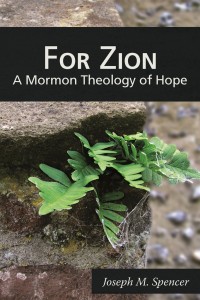 Chapter 8, “Zion in Prophecy,” marks an important transition in Joseph Spencer’s For Zion. Opening with a tour de force theological dissection of hope in Paul’s Epistle to the Romans, followed by a thoughtful interlude on the Book of Mormon’s conceptual bridge between Paul’s early Christian hope and the Zion of the Restoration, the book turns in chapter 8 to what most of us came expecting: Spencer’s close reading of Joseph’s latter-day revelations on consecration and Zion.
Chapter 8, “Zion in Prophecy,” marks an important transition in Joseph Spencer’s For Zion. Opening with a tour de force theological dissection of hope in Paul’s Epistle to the Romans, followed by a thoughtful interlude on the Book of Mormon’s conceptual bridge between Paul’s early Christian hope and the Zion of the Restoration, the book turns in chapter 8 to what most of us came expecting: Spencer’s close reading of Joseph’s latter-day revelations on consecration and Zion.
The analysis opens with an overview of the historical moment into which the revelation eventually known as D&C 42 arrived. Soon after Joseph’s arrival in Kirtland in February 1831, he recorded the earliest version of the revelation, introducing the Saints to the law of consecration and sketching the order in which the Saints were to live. Over the ensuing months and years, additional revelations arrived, gradually filling in the details of the new Zion in Jackson county.
This gradual crescendo came to a halt in the summer of 1833, which Spencer describes as a kind of collapse of Mormonism 1.0. Beset with mob violence in Missouri, the instability of the consecration economy in Ohio, and ongoing high-level defections, the Saints’ dream of Zion seemed to be dashed. The destruction of the printing press hard at work on the new Book of Commandments seemed to symbolize the ruin of the revelatory promises.
A re-boot flickered to life in 1835, with appearance of the significantly revised Doctrine & Covenants, and in 1836, with the completion of the Kirtland temple. Spencer characterizes this transition as a shift from early Mormonism’s unfolding, organic developmental mode to a newly systematic, hierarchical, and ornate vision of Mormon priesthood — a vision physically captured in the architecture of the Kirtland temple. This same change in mood captures the difference between the early Book of Commandments, with its chronological, developmental account of the Restoration movement’s beginnings, and the new Doctrine & Covenants, organized as an institutional handbook for an increasingly complex church.
This historical narrative will guide Spencer’s analysis of the textual evolution of section 42 over the next several chapters of the book. But first he introduces an important additional layer of historical context: the meaning of Zion in the eschatological prophecies of ancient Israel, taken up, crucially, by Paul in his discussion of hope in the letter to the Romans, as we have already seen. Spencer brings these strands together by zooming in on a phrase added to the what is now D&C 42:30: “And behold, thou wilt remember the poor, and consecrate of thy properties for their support.” Spencer notes that this phrase, “remember the poor,” appears only twice in LDS scripture: in D&C 42:30, and in Paul’s letter to the Galations. Spencer sees great significance in this Pauline allusion.
Paul’s letter to the Galations recounts, in part, Paul’s efforts to collect money from his wealthy Gentile congregations and carry the funds to Jerusalem for the support of the impoverished Jesus-believing Jewish congregations there. Paul understood this effort as the beginning of a new sort relationship between Jew and Gentile, one in which the Gentiles, moved by faith, hope and love, materially aid in the promised redemption of God’s chosen people. Paul saw this effort as the fulfillment of Old Testament eschatological prophecies, some of which are intimately familiar to LDS readers because they feature so prominently in the Book of Mormon. Isaiah 49: 22-23, for instance, foresees a time when Gentiles will carry the dispossessed sons of Israel home “in their arms, and thy daughters shall be carried upon their shoulders. And kings shall be thy nursing fathers, and their queens thy nursing mothers: they shall bow down to thee with their face toward the earth, and lick up the dust of thy feet.”
This image appears again and again in Old Testament prophecy: the spectacular pilgrimage of the Gentile nations to Israel, at last recognizing the Lord and his covenant people and casting their riches at the feet of Israel. Israel thus “sucks the milk” from the Gentile nations, who do all they can to “temporally redeem the people who had borne the Lord’s name and covenant throughout human history” (93).
While the Book of Isaiah sees the fulfillment of these prophecies in the return of Israel from Babylon, aided by the Gentile Cyrus of Persia, the Book of Mormon instead situates that fulfillment in the Restoration of the latter-days. Bringing the argument full circle, Spencer sees its first glimmers in the closing language of D&C 42: “I will consecrate the riches of the Gentiles unto my people which are of the house of Israel.” Thus the latter-day work of consecration is grounded in covenant. The covenantal bearings of consecration will find their latter-day fulfillment in a “global redemption of Israel among all nations, undertaken by those willing to consecrate everything in their possession to see God’s plan for human history brought to its final culmination” (93).
With these historical backgrounds in place, Spencer is ready to tackle D&C 42 itself. Stay tuned for my re-cap of Chapter 9, coming soon.
